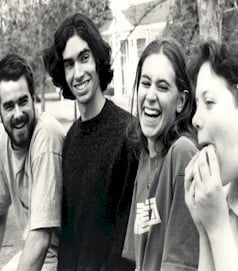Not even mad-potter Josh Lynch’s latest McGyver-esque contraption, an air compressor rigged to send small balls of wet clay sizzling through the air, can account for the volume of clay spackling every wall, ceiling, object, and person. Glimpsing through a window into the pottery studio conjures up images of the debris-torn battlefield of a war: The Great Clay War.
Clay bombs have left shrapnel on every surface. The floors must have been the scenes of dead dripping clay forms dragged across the studio’s old wooden beams. The potters are covered in gore of wet and dry disgorged against their bodies. To an outsider, at first glance it might seem the clay was winning, but one look into the kiln after a firing assures even an amateur observer that its side doesn’t even stand a chance.
Who is our great general overseeing and conditioning the troops that force the malleable enemy to conform to demands of beauty and function? It is Charlie Tefft.
Tefft, 27, is from Maryland. He graduated from Guilford College in 1997 and is now a part-time professor.
Josh Lynch, a pottery major, says, “He’s the best pottery student at Guilford. Being a good role model is worth much more than being a good teacher, but the fact that he is doing both is incredible. He has concentrated on helping students be able to look at their own work, rather than be obsessed with grades. He makes them able to be self-sufficient, and helps them see what is good pottery to them.”
Major Phil Haralem says, “Charlie went to Guilford and is now a professional potter. He is an inspiration to all of us. I’m a pottery major because he is here. It’s as simple as that.”
Who are General Tefft’s top pottery majors, his aces on the ground that make clay quiver at a mere turning of their pottery wheels?
Major Joshua Lynch: “If I had a choice between good fellatio and this last kiln firing, I’d pick this last kiln firing!”
This semester Lynch is taking an independent study in the formulation of copper red glaze, which hopefully will turn a color he calls “bloody and flamboyant,” beer bottle casting, to go alongside his recent home-brew making, and is serving as a teaching assistant for ground troops in Pottery 1.
Major Katie Elkins: “I love art, and pottery is a facet of that. Pottery specifically is rewarding as well as relaxing. That’s why I do it.”
Elkins is currently working on her senior thesis. She is making pots around two and a half feet high, carving imagery involving her search for truth.
“My thesis is on duality,” she says. “The relationship between gods and monsters, be they internal or external… Like creativity and destruction, how sometimes creativity brings destruction, sometimes destruction brings creativity. I’m exploring their nature in context to each other.”
Major Nicole Willcox: “Pottery is centering. It’s good to have something in my life with a little balance…”
Willcox is currently hypothesising on a final project this semester that would encapsulate the theme of addiction into her pots.
“I would like to make different forms for each addiction,” she says. “Cocaine, cigarettes, and anorexia are a few possibilities.”
Major Phil Haralem: “Last night I dreamt about throwing pots, throwing forms over and over again in my sleep… I got up and I was tired… If we could, we would be in here 24 hours a day.”
Haralem is working at becoming a proficient traditional functional potter, as well as combining his love for painting in glaze application.
Major John Boyd: “Pottery is a celebration of life. In its form it has the ability to hold two of life’s necessities: food and water.
To receive a raw material from the earth and to create with that is a precious gift. “
Boyd is studying the interaction between form and glaze, specifically, a type of traditional Japanese glaze labeled Shino: “Shino glaze has a life of its own,” says Boyd.
“Depending on the size and shape of a pot, where it’s put in the kiln, and the brushstrokes and thickness of the glaze, colors can range from blacks to oranges to white- speckled black, and more.
I can put a hundred different pots in the kiln with this glaze on, and none of them will look the same. I’m learning to control my variables for desired effects.”
Major Lynch says of pottery in general, “I feel like it’s given me an outlet for creative expression that is easily tailored to my needs as they change and as I grow.
For me, the functional aspect is the main reason why being good at making pottery makes me feel useful and well balanced. It’s the creation of life, the pottery is hands — the original vessel.”
These students are some of, if not the most, dedicated, inspired, and motivated students on campus.
They nod in agreement when discussing the need for recruiting high school students interested in pottery to better the program. They see tremendous possibility and potential in the pottery department and in their own development in the coming years.
In time, I’m sure they hope Guilford will develop a “Potters’ Army” equipped to take over the pottery world for generations.

